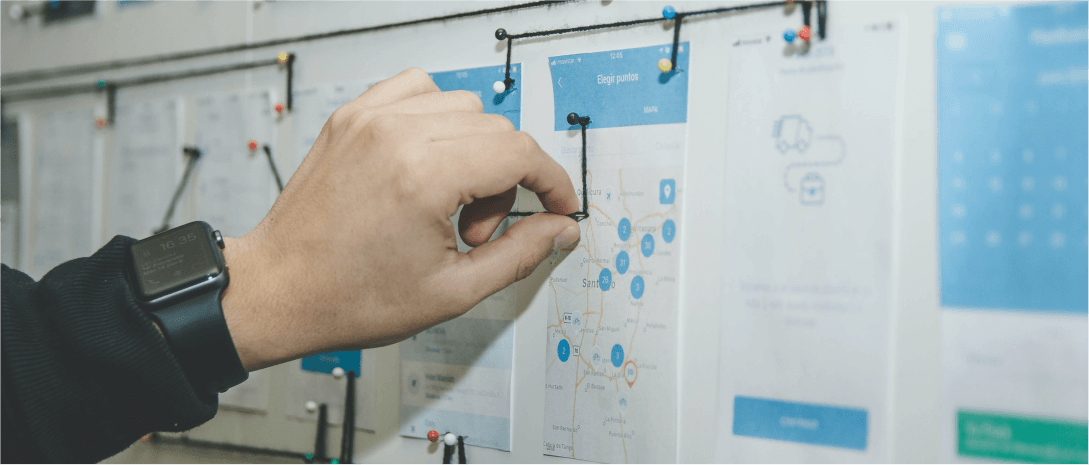Wireframing Service
Let’s work together !
We can deliver a complete bespoke solution, supply a dedicated team of experts, or provide an extension team to augment your staff.

What is a wireframe?
Before we delve into the purpose and benefits of creating wireframes, let’s start with what wireframes are.
Wireframes are basic two-dimensional low-fidelity layouts of your digital product. In other words, they are the structural guidelines for your product. Think of them as initial blueprints of your website or application.
Since they are only representations of your product’s initial concept and functionality, wireframes can be either hand-drawn or created digitally with a variety of software and tools.
Wireframes typically contain these three main characteristics:
Simplicity: since wireframes are just initial outlines of your digital product and are often adjusted during the design process, there is no need for them to be overly polished.
Grayscale color scheme: to keep wireframes and the creation process simple and time-efficient, they should be done in back and white.
Brevity: teams need to refer to wireframes more than all other documents, so they should be short, concise, and easy to understand.
Wireframes are used to communicate a variety of UX design concepts, including:
The structure of navigation architecture
The layout of a digital product
Where and how content will be placed
The functionality of a product
User flows and behaviors
Since wireframing can be done quickly, some people are tempted to ignore it. However, the benefits of creating wireframes far outweigh any inconveniences you may encounter.

What is the purpose of wireframing?
Here are the top two purposes of creating a wireframe:
Validating your digital product’s structure
Wireframes are like the foundations of a house. They act as a physical structure that keeps everything supported and working correctly and efficiently, and they also form the basis for future design plans.
For this reason, wireframes are used as the foundation of your digital product, because they provide a frame that ensures your product runs smoothly and effectively.
Identifying usability issues
Wireframes force you to push usability to the forefront of the design and development process. Displaying your digital product’s pages with their layouts elements, and locations ensures that every aspect of the design is functional.
Without elaborate colors or intricate images, you and your team can focus on what’s really important – the flow and navigational elements on your digital product, including conversion paths, navigation button placement, and more.
From here, let’s take a look at the benefits of wireframing and how it can drive success for your business.

How do wireframes benefit your business?
Wireframing is arguably one of the most important and effective tools in both the design process and the development of your digital product.
Here are our top four reasons why:
1. Creating user-focused products
Wireframes are an effective way to communicate ideas and plans with everyone involved in the design and development process from teams working directly on the project to stakeholders.
With wireframes, you can eliminate distractions and keep everyone focused on what’s really important for your users.
For example, a common topic of discussion during the design and development process is where various elements should be placed. By using wireframes, UX designers are less distracted by issues like whether the color scheme works, allowing them to concentrate on positioning navigational and CTA elements in the most effective places on each page.
In short, the simplicity of wireframing makes the design and development process more straightforward, saving your team both time and money without sacrificing quality.
2. Clarifying and defining features
Among the most helpful things that wireframing offers is clarity. Wireframes allow you to mock up most aspects of your digital product’s functionality and identify problems early on in the process. Ultimately, this saves resources by reducing the need for fixes further down the line.
Since wireframes are generally cheap, quick to produce, adaptable, and flexible, they also helps your team clarify and confirm the best design options for your users at a low cost.
Simply put, wireframes enable you to map out the functionality of your digital product early on in the design and development process, which streamlines the entire process.
3. Gathering feedback
Wireframing is also a great tool for gathering feedback about the flaws and shortcomings of your digital product. It allows for discussions to focus on the functionality and effectiveness of the product, ensuring that you’re creating something that your users will want.
Without wireframes, your design and development teams could be creating a high-fidelity, pain-staking, and time-consuming digital product only to realize later that it has numerous functionality issues. And at that point, making U-turns and corrections could be extremely costly for your business.
4. Better content development
Dumping big chunks of content across your digital product’s pages is unattractive and directly impacts your users' experience.
Wireframing helps identify areas that aren’t user friendly, so that design teams can reformat various text and image blocks to better appeal to users.

Common misconceptions about wireframing
Despite the fact that wireframes serve numerous significant purposes, some people still choose to skip this crucial step due to common misconceptions.
Here are the two top misconceptions about wireframing, which we’ll debunk:
1. “We’ll save time and increase efficiency if we skip it”
Although bypassing the wireframing stage might seem like a promising way to save time, skipping it only costs more time and money down the line.
As previously mentioned, wireframes are the frame of your digital product, so skipping wireframes is like trying to put up plasterboard walls in a wooden house without a building a frame for them first.
Despite the seemingly functional and attractive appearance of the house, it will fall apart in a matter of time. Then, you’ll spend a lot more time and resources trying to fix something that shouldn’t have been broken in the first place.
2. “We can get what wireframes give without actually doing it”
Wireframes are often neglected and ignored because of how fast and easy they are to create, leading many people to believe that they can be substituted with something else.
By skipping the wireframes, you might be at risk of forgetting or neglecting the following: prioritizing information, creating an effective structure, designing a UX-focused architecture and more.
What are the main types of wireframes?
Similar to prototypes, there are also different types of wireframes, which are differentiated by how much detail they have.
Let’s take a closer look at the difference between low-, mid-, and high-fidelity wireframes below:
Low-fidelity wireframes
Low-fidelity wireframes are the most basic form of visual representation of your digital product, much like a first draft.
These wireframes are created without any fixed scale or accuracy and are fairly rough. They are the sketches before a masterpiece and tend to include basic details, including simple shapes and mock content like labels and headings.
Low-fidelity sketches are a great way to get discussions started when you’re deciding on every aspect of a digital product, from the layout of the navigation to user flows.
Mid-fidelity wireframes
Next, we have mid-fidelity wireframes. These wireframes are the more refined versions of the rough sketches, featuring more accurate representations of how your digital product will look and function.
These mid-fidelity wireframes assign various specifications on element sizes, spacing, and fonts, making them look cleaner and more refined than their low-fidelity counterparts. As you can see, compared to low-fidelity wireframes, mid-fidelity wireframes take on more of the shape that the actual digital product will look like.

High-fidelity wireframes
Lastly we have high-fidelity wireframes. These wireframes are the most advanced and accurate visual representations of your digital product.
These wireframes have the highest level of detail and are pixel accurate as they are usually done digitally. Some headings or subheadings may be filled in at this stage and different shades of grey may also be used to indicate different design elements. However, complex graphics or imagery are not recommended to reduce the chances of distractions.
Compared to mid-fidelity wireframes, the shading, shapes, and lines have been refined and appear to be more professional and finished.

How do we approach wireframing?
Creating wireframes is one of the simplest ways to visualize your digital product.
Despite the simplicity of wireframes, you might be unsure of how to approach them. Here are our top three ways we approach wireframing:
1. Conduct extensive research
Research provides valuable long-term insights on the issues that your users might face, allowing you to create the perfect digital product to elevate their user experience.
Before beginning the development process of your digital product, our teams conduct a great deal of user research including the following:
User interviews
Stakeholder interviews
Customer journey mapping
Web personas
User flow charts
And more
We then translate our into visual forms as wireframes. Both the qualitative and quantitative data we collect from users and stakeholders play a significant role in how we approach their creation and how we move forward every step of the way.
For example, creating user flows or customer journey maps gives us a clear understanding of how many frames we should be aiming for during the wireframing process. This means that we save time by not creating too many wireframes, and with the limited number of wireframes we have, we can guarantee quality.
By conducting extensive research, we deepen our understanding of our users' behaviors, goals, motivations, needs, and more, allowing us to create the most accurate product for them.2
2. Organize and sort our data
With the abundance of data we collect over the course of our research process, it becomes hard to both retain and recall all that information.
We keep our collected data organized and easy to refer back to throughout our process by turning them into a cheat sheet. We outline our users’ greatest concerns to remember what to avoid, their biggest motivations and desires to understand the information hierarchy, and so on.
Wireframing can get quickly messy, especially during the low-fidelity stage of creating wireframing where ideas are flying left and right. Organizing our collected data helps us save time and makes the process of creating wireframes more efficient.
3. Create drafts, not art
After our research and organization is complete, we finally start to create wireframes. This makes creating wireframes much easier.
To ensure focus and efficiency, we try not to illustrate wireframes. Details are unnecessary as wireframes are just outlines to represent the features and formats of a digital product. Instead, we approach wireframes as quick sketches to draft our final product.
Brands we’ve worked with
We believe in building strong partnerships that last.
We treat our clients as business partners, catering our services to help you grow your business in the long-run. In the past 15+ years, we have partnered with over 400 of Asia’s biggest brands in various industries to help them digitize their business, including:

Insurance
Manulife, Oohoo
Publishers
BBC, TopGear, Burda Thailand
E-commerce
Ascend, Ocean Glass, Das Intergroup
Travel and Hospitality
Ascend, AskAva, Gogojii, Co Van Kessel
Financial Industry
SCB, OmiseGo, 2CP
Food Delivery
Food Panda
Health Care
Bangkok Hospital, Bumrungrad International Hospital
Consulting
BCG
Self-storage
Redd
Real estate
Arthur Online, Home Connect
Education
Starfish, AIP Internship
Meet our UX / UI design team
At Morphosis, we have a vibrant team of experienced UX designers who are focused on delivering high quality impactful results for our clients.
We fully embody the belief that people come first, putting the interests of our clients and the needs and desires of end users at the forefront of everything we do.
Our practiced and proven service model includes:
